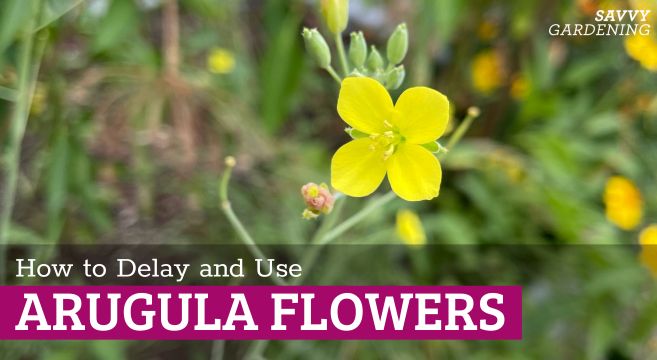This post may contain affiliate links. If you make a purchase through links on our site, we may earn a commission.
Arugula seeds are always on my “to-plant” list. I enjoy the spicy, peppery flavor of the serrated leaves, harvesting them to add to salads and stir-fries, or to put on pizza. Arugula flowers are their own delicacy, adding a unique flavor to savory dishes. In this article, I’m going to share some tips on getting the most out of your arugula harvest, what to do with the flowers, and how to save the seeds to grow more.
Arugula is referred to by different names in other parts of the world. It’s worth noting because if you’re searching for seeds or recipes in countries outside North America, they may be hard to find unless you use the right terminology. Arugula’s origins lie in Mediterranean countries. In France, arugula is called roquette. The seeds are often included as part of mesclun salad green mixes, a blend that originated in the region of Provence that includes endive, chervil, leaf lettuces, and arugula.

In the U.K. (and Australia), the word roquette was shortened to rocket. In Italy, the word rucola derived from the Latin eruca. I could take you deeper down an etymological rabbit hole, but my point is there are many different types of arugula, which I’ll explain below.
Different types of arugula
Part of the mustard family, arugula is a cool-weather loving crop. Seeds are sown early in the spring, and can be planted consistently throughout the season for frequent, uninterrupted harvests.
As the weather warms up, arugula will continue to grow, but hot, dry weather will cause it to bolt. The plant will shoot up a long, leggy stalk, forming flowers and seed pods.
You may have noticed in photos or on seed packets that there are different colors of arugula blossoms. That’s because there are numerous types of arugula you can grow. The most common types of arugula are wild arugula (Diplotaxis tenuifolia), which is a perennial, and a cultivated annual arugula (Eruca sativa). The former is slower to germinate and to really get going in the garden. Leaves are longer and more slender, almost like a dandelion’s. The latter has more rounded leaves, is quicker to bolt, and can have a milder flavor. A point goes to wild rocket/arugula for not being fussy about poorer soils.

Heat-tolerant varieties of arugula that are slower to bolt, include Astro, Garden Tangy, and Sylvetta.
Tips to slow arugula from flowering
Arugula will flower eventually, but there are a few tricks you can use to slow down the process. Just as you do with herbs, like basil and cilantro, harvesting often will help to delay arugula from flowering. It also means you are always harvesting the leaves when they are young and tender, and less potent. Always harvest the outer leaves, which allows for new growth to continue.
Seed packets will recommend planting arugula in full sun. But planting it in an area that gets a little bit of shade or under plants that will shield it from the sun, while still allowing a bit of light to get through, can help it flourish for longer.

Shade cloth over row cover hoops or stakes can help to cool the soil and protect arugula from hot, sunny days. If your arugula has been planted in a container (and you’re able to lift it), move it out of the sun to an area that gets a bit of shade.
Water your garden deeply and consistently during dry spells. This can also help delay the plant from producing seed.
Harvesting arugula flowers
When you do see signs of bolting, you can try to delay it a bit by removing the arugula blooms (unless you want to save the seeds). Use a pair of herb scissors to gently remove them. The best part is you can eat them, too. Arugula flowers are edible, with a similar peppery taste to their leafy green counterparts. If you’re going to use arugula flowers as a garnish, harvest them as close to plating as possible so they don’t wilt. You can also leave arugula flowers for beneficial insects to enjoy in the vegetable garden.

Can you still eat arugula after it flowers?
Eating arugula leaves after a plant has bolted will depend on an individual’s taste. Some will say it tastes too bitter or spicy, while others will continue to harvest arugula leaves. It can also depend on the variety you are growing. After annual varieties flower, mature arugula can be pulled to make space for another crop.
Perennial arugula will continue to produce leaves after the plant has flowered. If you allow arugula seeds to fall as they dry out, you can expect to eventually discover new arugula plants. Or, you can save the seeds before the pods open. Once the seed pods seem to be dry and are no longer green, they are ready to harvest. Snip them into a paper bag or bowl as the pods can be fragile and open when touched. Allow the seeds to dry for a few days indoors. Store your seeds in a cool, dry place and don’t forget to plant them the following year!

More greens to grow
- Start a salad garden
- Red lettuce varieties
- How to plant lettuce
- Sowing Romaine from seed
- The best types of kale
- Growing spinach in containers




Leave a Reply